In simple terms, decibels are the way we measure sound. But noise and quietness is so much more than a numerical measurement. At Meaco, we understand the importance of quiet home appliances, the harmony of these noises and the effect on your everyday life.
As I sit at my desk, looking at the MeacoDry Arete® One on my left, I’m considering the other dehumidifiers I’ve had in the past. The difference of 5dB between 35 and 40dB may be easy enough to disregard, but it’s also the gentle hum of the machine that makes it even easier to tune out – especially in a small home office. Essentially, we’re looking for an appliance that is functional and powerful whilst making as little noise and irritation as possible in my home.
What are Decibels, really?
The soft purr of the cat on your lap, the whisper of a grandchild telling you a secret and the loud blare of an ambulance passing on a nearby street. How do we measure the volume of all these different sounds? In one word, the answer is “decibels” or “dB”.
It’s a term many of us have heard of but it can be difficult to pinpoint what it really means. And, as we fill our homes with more and more gadgets, making our lives easier but sometimes a little noisier – quieter appliances have become an ever-growing focus. When we think about decibels it can be easy to think only of loud noises, like fireworks or aeroplanes; but actually, decibels are important measurements for quiet noises too, especially home appliances.
Understanding Decibels (dB)
Essentially, decibels are a universal unit of measurement. They are used to quantify the intensity of sound: ultimately, how loud things really are.
Here at Meaco, we like to be completely transparent by providing dB measurements on all of our products. We like to show how quiet our products are so you know what you’re buying: from the brushless DC fan motor inside of aMeacoFan Sefte® 10” Air Circulator (25dB) to the compressor inside of a MeacoDry Arete® One 6L Dehumidifier and Air Purifier (32dB).
What do we mean by “whisper-quiet”? You’ll notice this on a lot of Meaco products and this is because they are just that – as quiet as a whisper! Take a look at our decibel comparison chart, the noise level from our MeacoFan Sefte® or 1056 ranges are at the same level as a whisper in a library. That is phenomenally quiet!
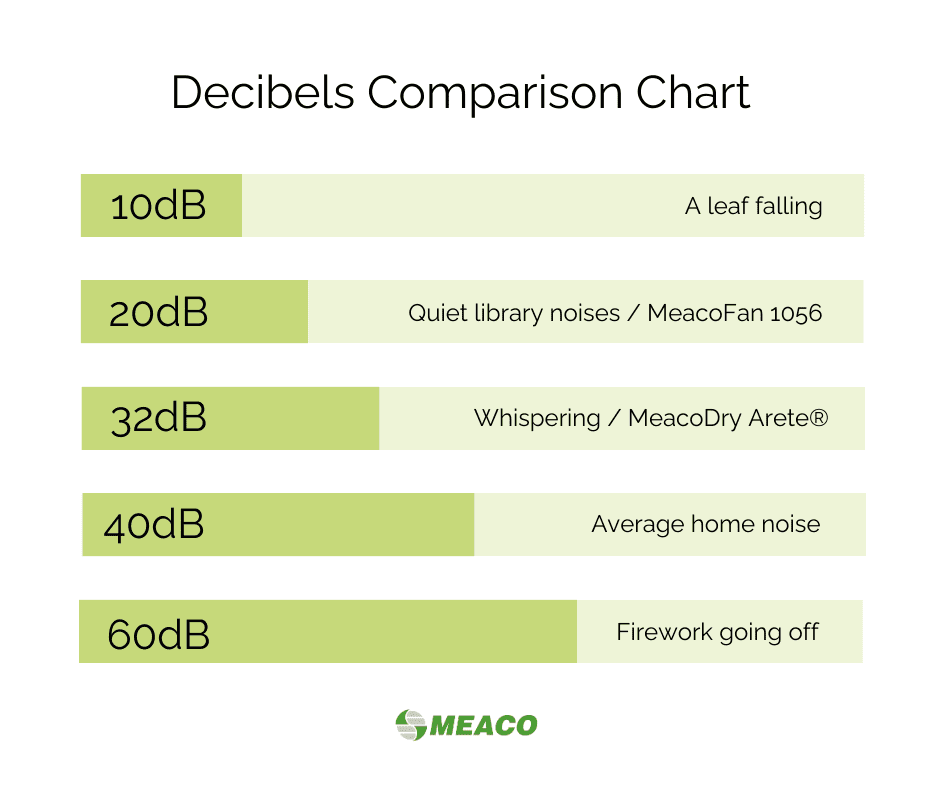
The lower the dB value, the more quiet the operation is.
The important thing to note about decibels is that it’s an exponential scale, not a linear one. So, unlike scales such as those found in traditional rulers or thermometers, the dB scale ‘increasingly increases’ as it were.
For every 10-fold increase in sound intensity (decibels), the dB level increases by 10dB. This also means every 20dB increase (2x sets of 10dB), will increase 100-fold, making 20dB 100 times louder than 0dB.
So when we say our MeacoFan Sefte® measures less than 25dB (compared to 50dB from similar products available on the market), you know it really is very quiet.
How are decibels measured?
One of the most common questions we receive is “why is the app on my phone / my recording device measuring a different dB level to what is stated on your website?” This is because the noise level listed on our website is the sound power level and noise level recorded at home is the sound pressure level.
All dB levels on home appliances are measured in specialist lab conditions. These are silent and sound proofed booths and very different from a home environment! So, while it’s important to look at the dB level in the technical specifications when shopping, remember you won’t be listening to the product in isolation in your home.
As an example, when testing the dB level of our MeacoFan range the air circulators are tested in special sound chambers in independent laboratories which ensure the product is being tested in an environment where there is 0dB background noise. The lab is then able to measure the noise level on each individual fan speed, on all four sides of the air circulator and take an average of those four measurements. This is repeated ten times on different air circulator from the production line. This is called the sound power level.
What you are able to measure in your domestic environment is called the sound pressure level. The sound pressure level is a different measurement and will take into account all background noise and then all other factors e.g. distance from the fan the measurement is taken at and the quality of instrumentation used.
Therefore the dB level stated on our website and the dB level measured at home will always be slightly different as they are two different measurements.
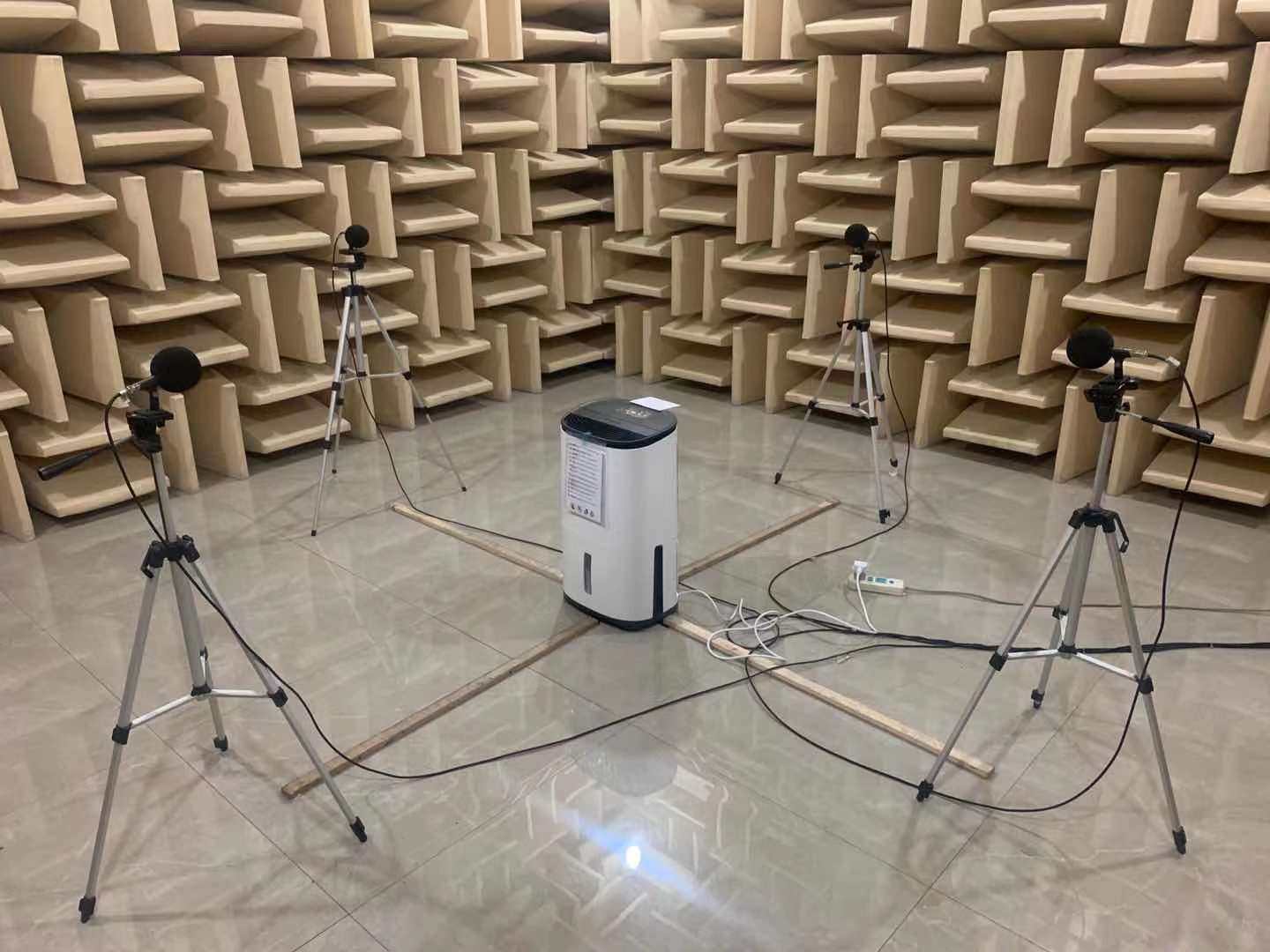
What does harmonious or seamless living mean when we’re talking about sound?
When we talk about seamless living in terms of noise levels, it’s not just about decibels. We’re looking to create a pleasant ambient noise rather than the grating noise of electronic elements out of balance.
In the same way you may play a harmonious chord on the piano, it may be loud (played forte) or quietly (mezzo-piano) and be pleasant on the ears. But no matter if it’s your bouncing 3 year old slamming the keys or a virtuoso tapping the wrong notes ever so quietly, the sound can jar with us and sound unpleasant.
In developing our products, we have made a concerted effort to create harmony within our device’s electronics. Whether it’s the compressor and fan motor within a dehumidifier or simply the high speed fan blades working together in a fan, we believe harmony is as important as volume.
This is why the MeacoDry Arete®’s internal fan blades will slowly come to an end when you switch the device off rather than slam on the brakes. This is why fans such as the MeacoFan Sefte® and 1056 are as powerful as they can be, but still quiet enough and harmonious to help you sleep during hot nights.
Living with home electronics: what dB should you consider when placing products around your home?
Realistically speaking, we don’t look at dB or harmonious sound in isolation.
We have customers looking at a variety of different products and for different situations. “I’m using my fan to keep cool at night, it’s on my bedside so I need the quietest fan you have”, “I’m using my dehumidifier on the upstairs landing, I’ll be passing it throughout the day but I’m not sat working with it”, “I have condensation in my conservatory that I work in during the Spring so I need an effective but quiet dehumidifier”… What’s the best air treatment product for me?
We get these questions all the time.
So how do you select the right appliance? Not only for the right noise levels but also for your lifestyle and where you intend the product to be in your home?
If you’re looking for a desiccant dehumidifier to place in the garage, noise levels may not be such a priority. Whereas, when looking for a dehumidifier to sit in a living area where you watch TV every night, you may pay more attention to the dB so that you are not disturbed.
What are the noise differences between dehumidifiers?
Fans are a little more straightforward as they contain one main moving element: the fan blades. Dehumidifiers can be a little trickier as there are two main types.
If we start with compressor dehumidifiers, that’s the same technology as you’ll find in your fridge. Refrigerant is compressed around the internal components which creates cold surfaces and extracts water. More on how a dehumidifier works on our blog.
It’s very unlikely that you’ll tuck yourself in for a cozy night’s sleep next to the gentle grumble of a refrigerator. However, many dehumidifiers on the market are a little noisy.
So when you asked us for a compact dehumidifier, we worked hard to engineer the MeacoDry Arete® 6L to measure just 32dB. It’s ideal for light sleepers, nurseries, home offices or late-night study sessions. Whether you’re working late, winding down or sleeping through the night, you can leave it running confidently while it continues to clean and dehumidify the air in the background. No interruptions, just cleaner, drier air exactly when you need it most.
Desiccant dehumidifiers such as the DD8L Pro, have completely different technology under the hood. They are designed with a heating element which extracts excess water. Traditionally a little quieter and they offer powerful dehumidification especially in cold environments. We would recommend using these in a garage, caravan or boat over a bedroom.
How to consider noise when placing a dehumidifier
So, it’s not just about the decibels! It’s also worth paying attention to where you’re going to place a home appliance as this can dictate how important those high sound levels are. If a dehumidifier is on a high fan speed but in the hallway, it’s not going to seem as loud or invasive. If you’re looking for a dehumidifier for your home office space, as I did, then you may need to focus your attention on finding the quietest model available so your online meetings aren’t disrupted by a whirring noise.
As an example, let’s think about how you might do the laundry. The washing machine can be very loud, especially when on a spin cycle, at around 50dB. However, when your washing machine is in the utility room and the door is closed, the noise may seem distant and not bother you so much – probably feeling more like 35dB. The same goes for a dehumidifier drying clothes. Even on the highest fan settings for best performance, the dB will seem so much less in a utility room with the door closed.
For the optimal laundry drying with a dehumidifier, we would recommend the Meaco DD8L Pro Dehumidifier.
Equally, many customers run their dehumidifier on the upstairs landing or in a garage. High noise levels aren’t as much of a concern here as you may pass it frequently but it’s not positioned in a bedroom where you’re trying to sleep.
For 24/7 use on the landing or in the garage, you may be prioritising running costs over noise levels and we may recommend any one of our dehumidifiers such as the MeacoDry Low Energy 12L which measures up to 41dB or the MeacoDry ABC 12L, measuring at 36dB. For the garage specifically, we would recommend a desiccant dehumidifier from our DD8L Dehumidifier as it doesn’t mind low temperatures, even performing high extraction rates under 10°C!
However, for a quiet night in the living room or even bedroom, we would recommend our flagship quietest model. The MeacoDry Arete® Range has been specially engineered to measure just 32dB (that is phenomenally quiet!) and includes a Night Mode. Our quietest model is the MeacoDry Arete® 6L, it fits perfectly into bedrooms, nurseries and home offices without disrupting sleep, work or relaxation.
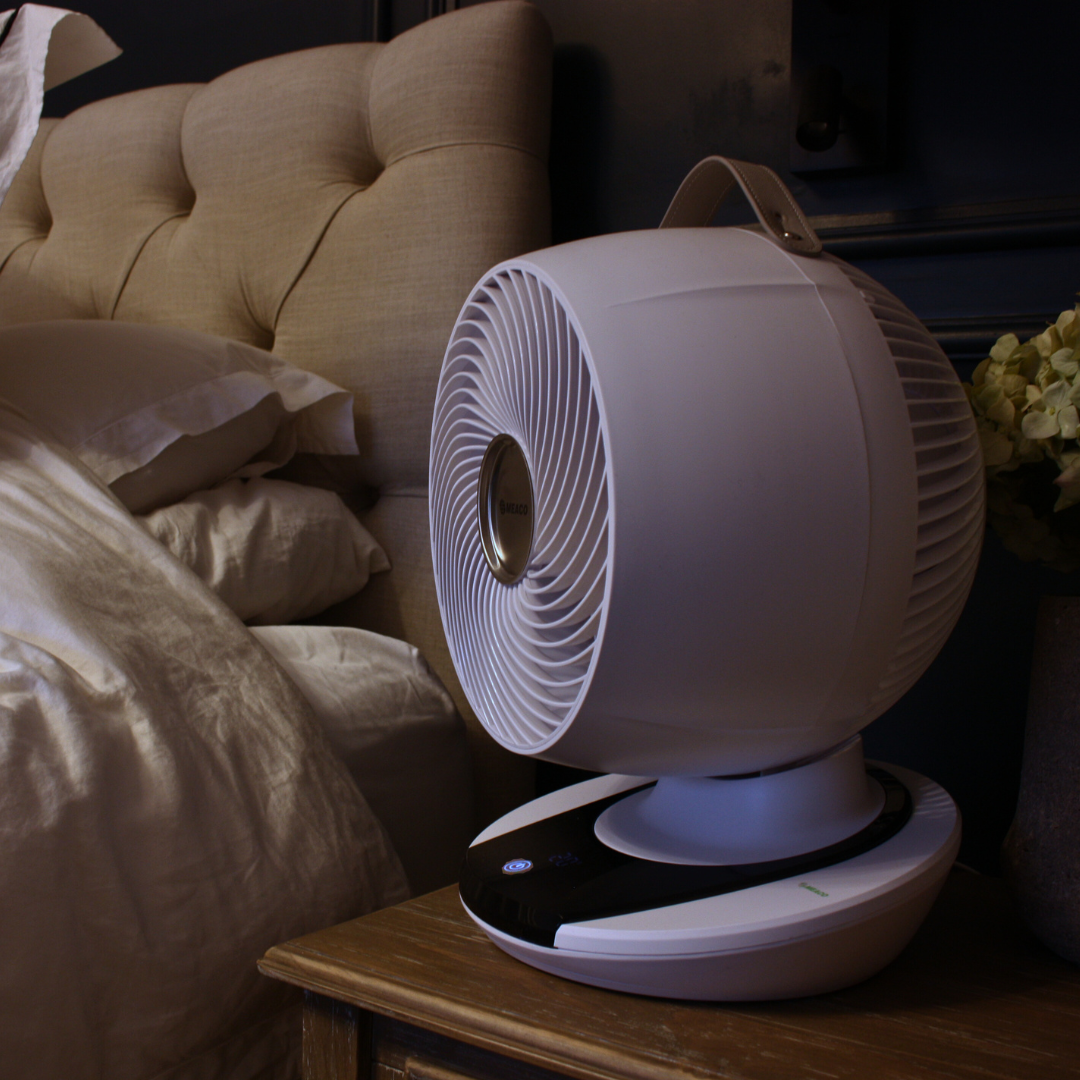
How can using Night Mode reduce noise levels and ensure a better night’s sleep?
The Night Mode operation is available on most Meaco Dehumidifiers and MeacoFans; and is available at the tap of a button.
The appliance will reduce fan speed to the lowest setting, switch off any lights or LED indicators and switch off beep sounds if you select other options. This allows you to keep the appliance running and dehumidifying or cooling – all, while you’re getting a restful night’s sleep.
Please note that if the unit is already on the lowest fan speed, you may not hear a difference. However, this feature will also prevent the device increasing its fan speed in response to environmental changes while Night Mode is activated. This means you won’t be woken in the night purely because your dehumidifier has read a higher relative humidity and has sprung into action.
What is the best choice for a whisper-quiet dehumidifier to quietly manage humidity in a bedroom? We’d recommend the MeacoDry Arete® One 6L, measuring just 32dB, it is phenomenally quiet. If it wasn’t for the powerful extraction rates and full tank, you’ll almost forget it was still running! So whether you’re working late, winding down or sleeping through the night, you can leave it running confidently while it continues to clean and dehumidify the air in the background. No interruptions, just cleaner, drier air exactly when you need it most.
How to consider noise when choosing the best fan for you
Let’s now look at cooling in the summer, especially on those hot, sticky nights. You’ll want to look for a fan which will keep you cool and give you a restful night’s sleep. Consider where the fan will sit; will it be on your bedside providing concentrated cooling or do you need an oscillating fan to keep the room circulated?
Our award-winning MeacoFan Sefte® range is our most quiet option, at just 25dB for the 10” Table and Pedestal models.. We have precision engineered Sefte® to provide the quietest and most efficient cooling. This is ideal for a bedside and can circulate air in narrow, medium and wide oscillation.
Another incredible option is our MeacoFan 1056 measures27dB and has also been awarded the Quiet Mark certification. Even with the multi-directional oscillation, the 1056 can move the air around the room to keep everyone cool without adding any additional noise. Understanding just how quiet 20dB really is will help you choose a fan which best suits you.
While dB readings are important to pay attention to, we would definitely recommend looking at the product placement and outcomes you’re looking for as well.
Meaco: Our Commitment to a Quiet Operation
We have consistently prioritised quietness in our products through design innovation and customer feedback. As a result, we have many Quiet Mark awards to our name.
Whether it’s for improved concentration in your home office, better sleep or simply enhanced comfort, our low dB ratings show our commitment to creating healthier and quieter living spaces. And, as technology continues to advance, we aim to continue getting better at making our products seamless components of a peaceful lifestyle in the future too.
Featured products:
- 3-in-1 Air Circulator
- Air Beam Precision
- Whisper quiet – from 25 dB
- Two-in-one excellence, designed for smaller spaces.
- Perfect for single rooms, student lets and houseshares
- Built to last: Free 5-year warranty
- Rechargeable and replaceable battery – designed to stay, not to be thrown away
- Easy to use
- Whisper-quiet (from 27dB)

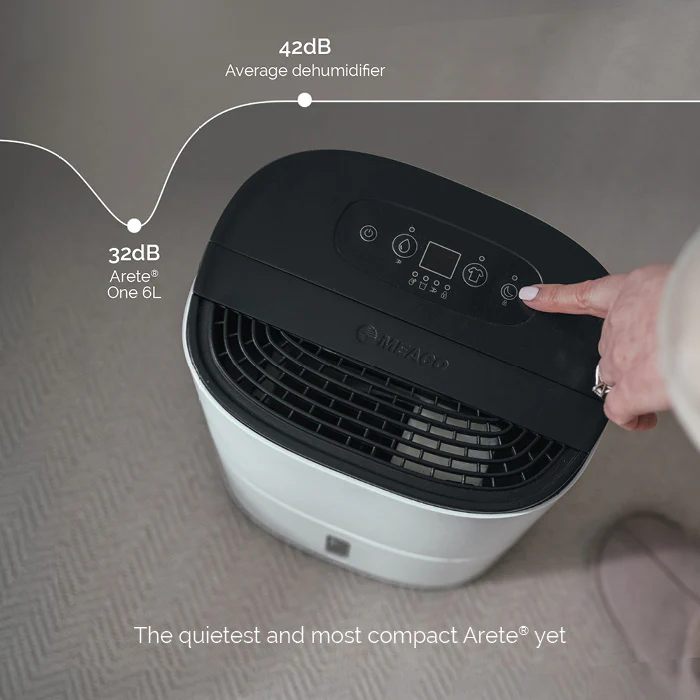
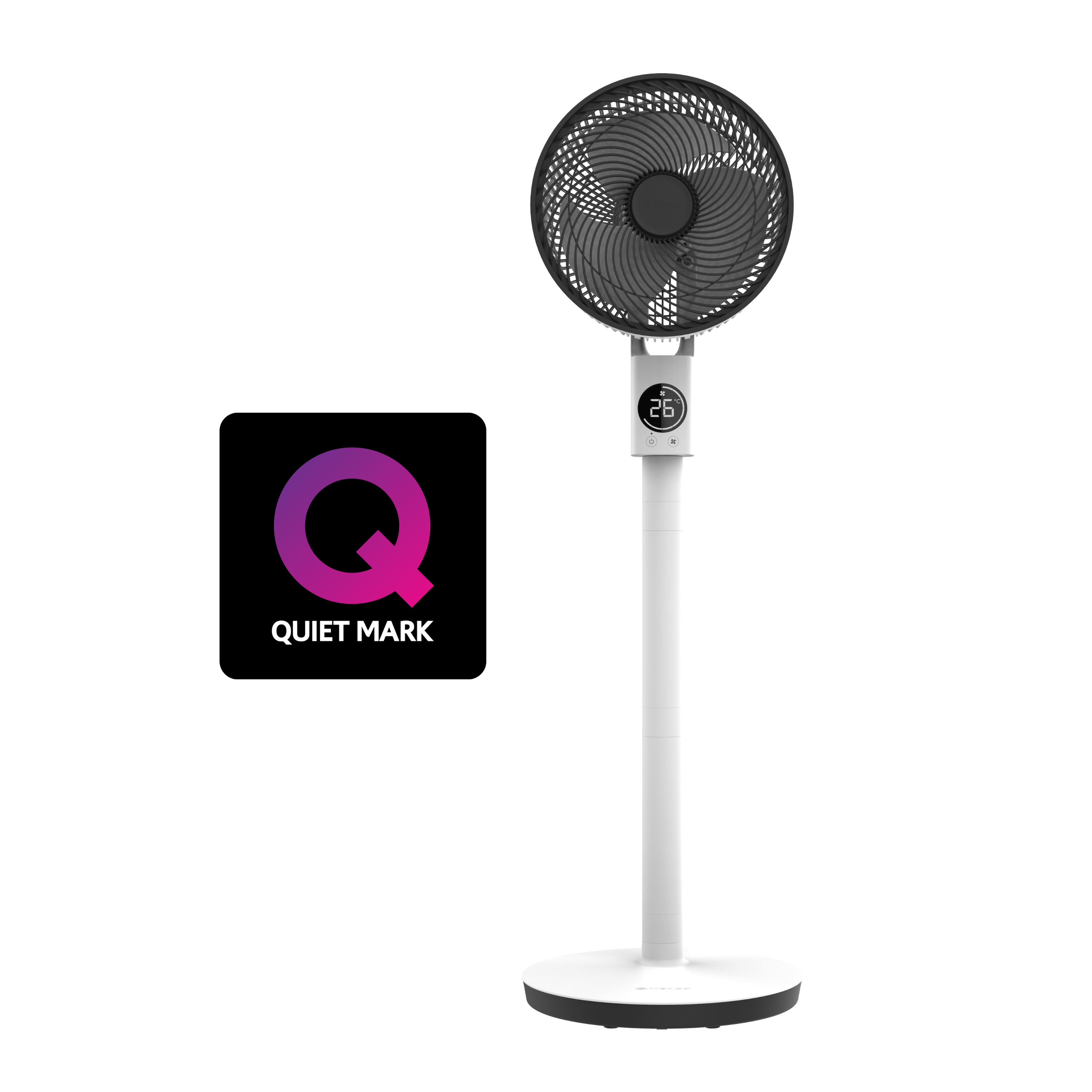
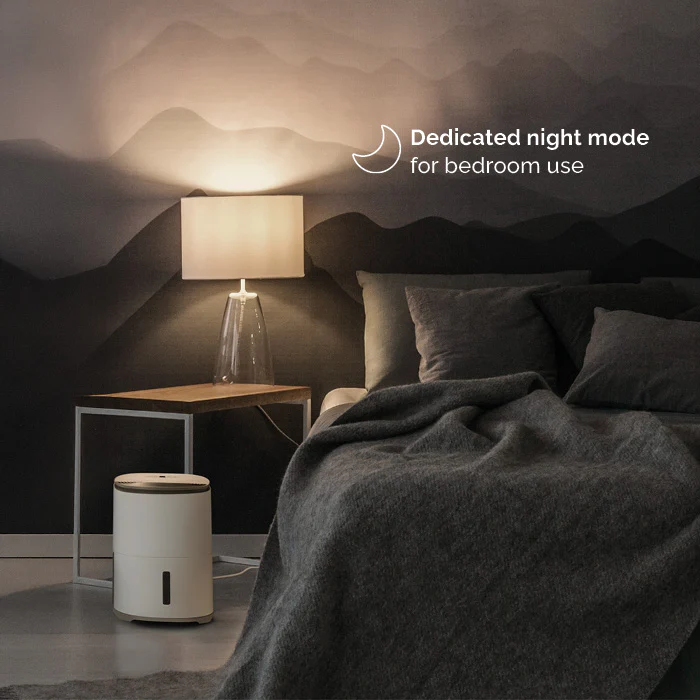
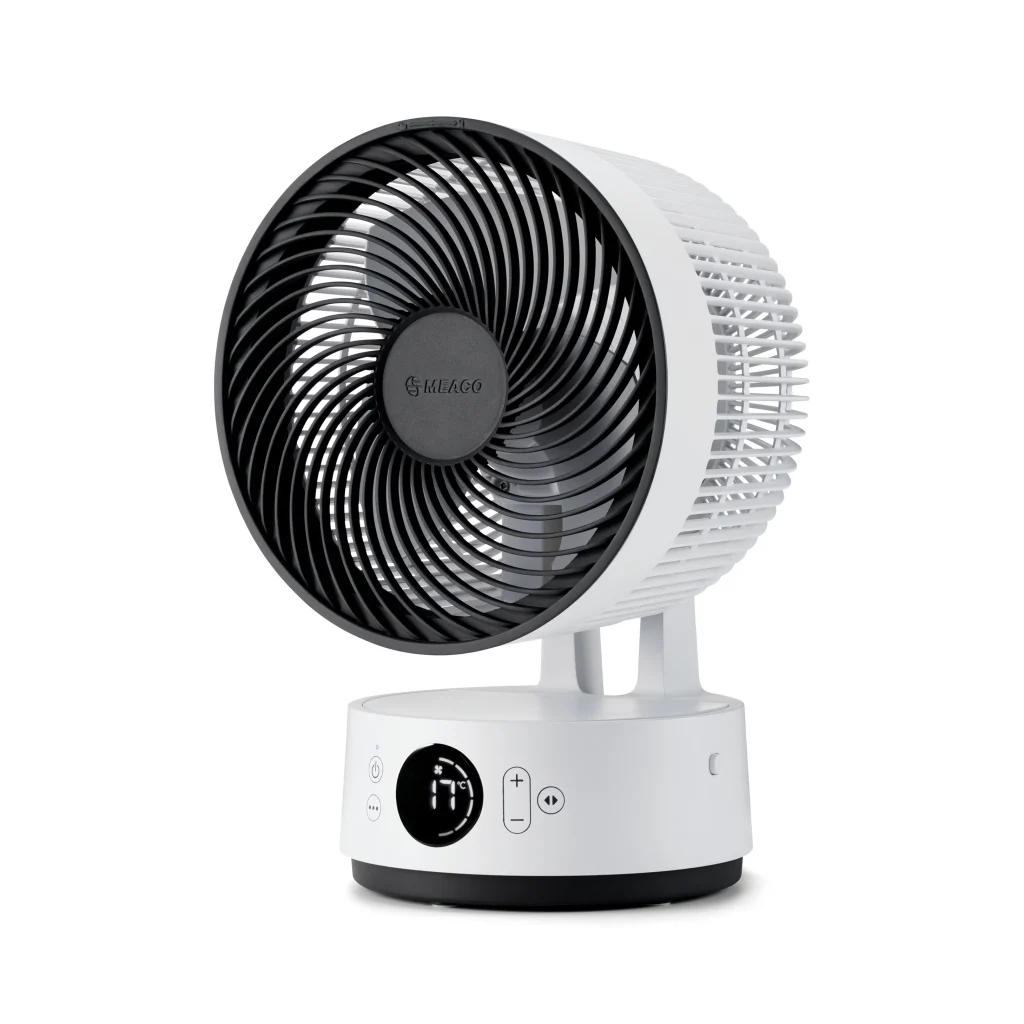
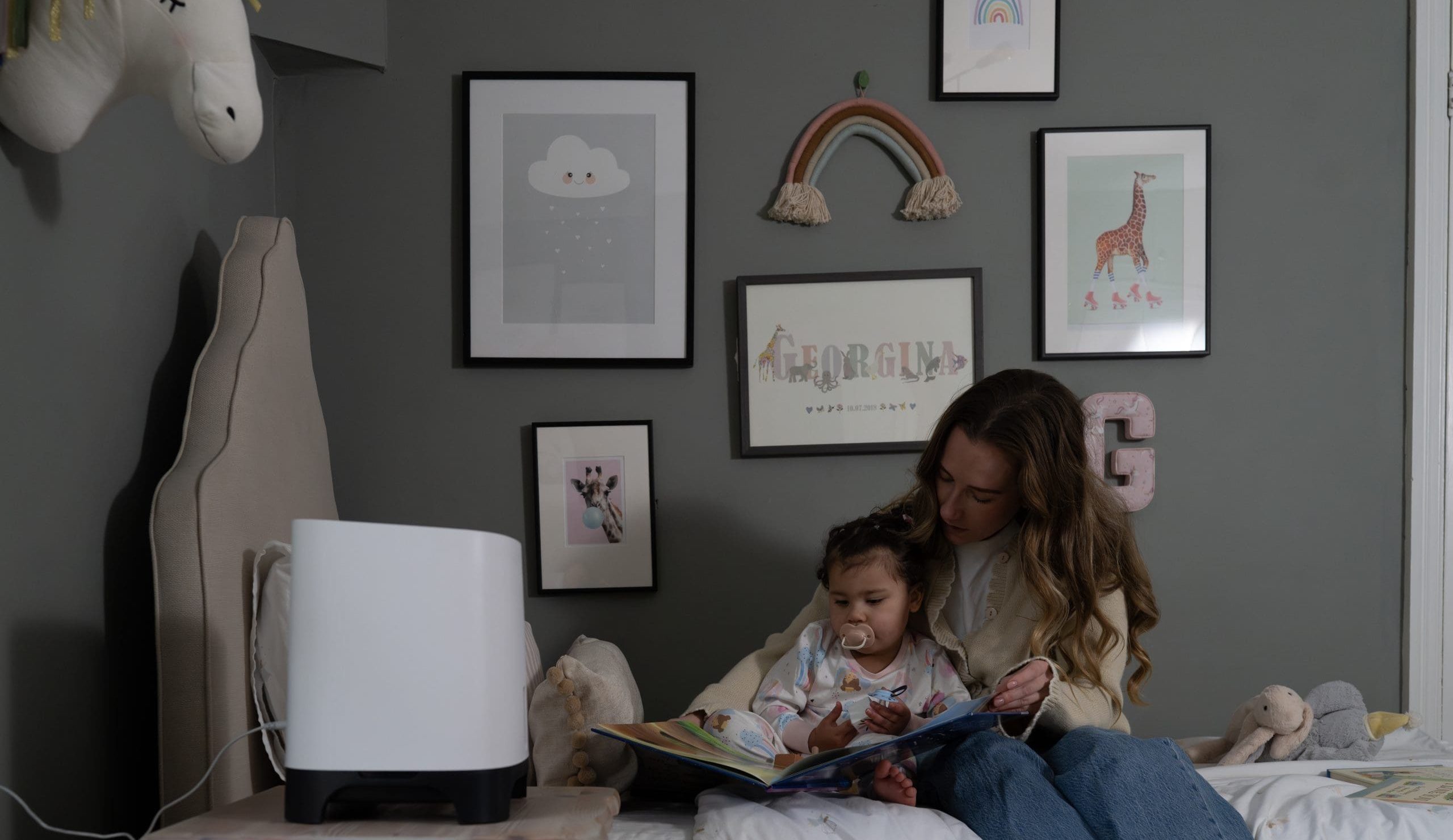



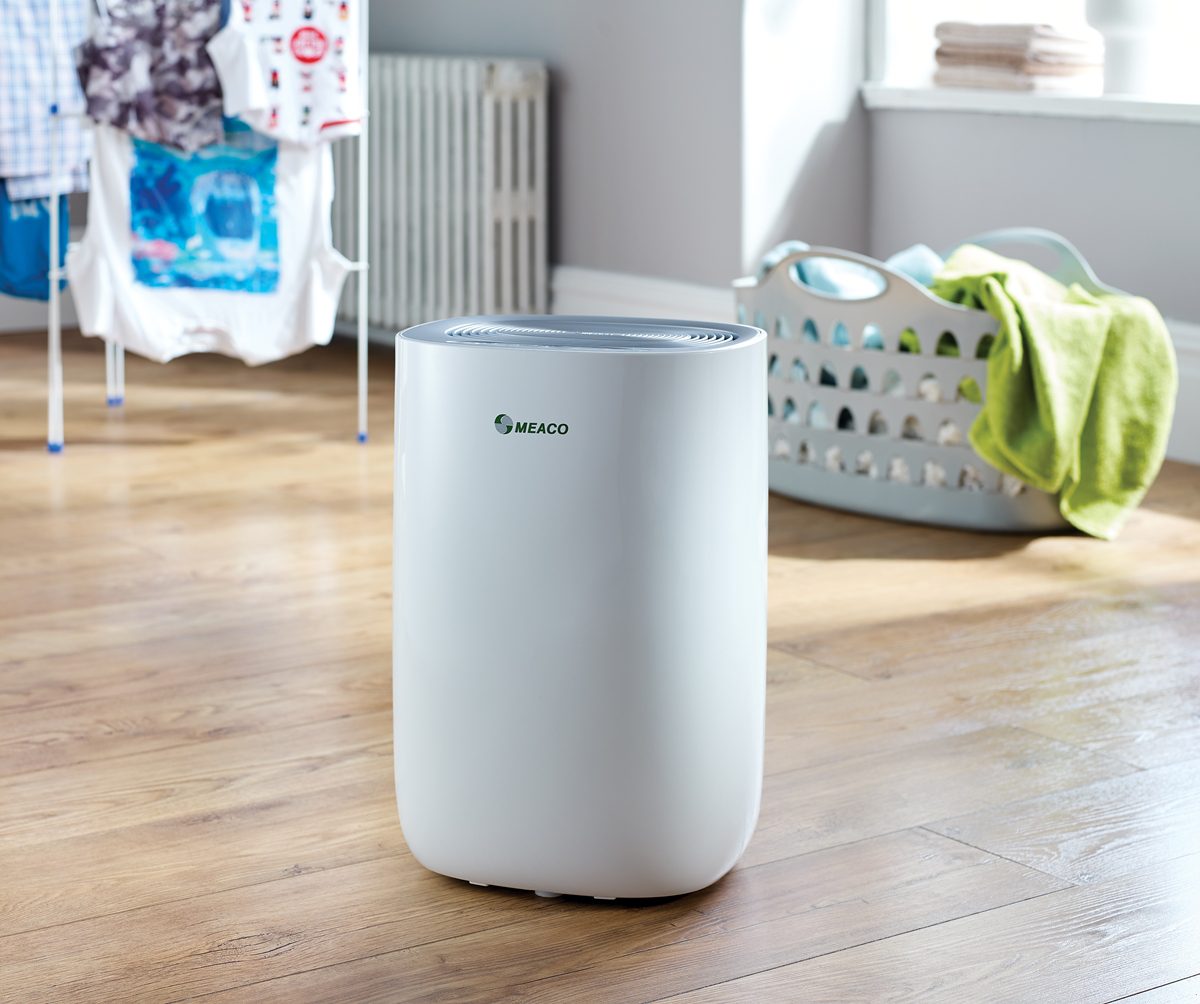

7 responses
Hi, I just bought an Arete One 10L dehumidifier. I turned it on for the first time ten minutes ago after letting it sit for 6 hours, and it is really loud.
I’ve read this blog and I still believe it is louder than advertised, will this noise lessen as the humidity lowers? It’s reading between 89–91 at the moment, is that making it louder?
I have it on the other side of the room at the moment and it quite a loud roar of the fan.
Please help, I live in a studio and bought the Meaco Arete as it is meant to be one the quietest ones around.
Alex,
Thank you for reaching out. I understand your concern about the noise level in your studio home.
In smaller spaces like a studio, the sound will certainly be more noticeable since there’s less room for the noise to dissipate, especially when the unit is running on high fan speed. The noise is louder when the humidity level is higher, as the dehumidifier works harder to extract moisture.
When the humidity level is 15% RH above the set target, the fan will run at high speed. As the humidity lowers and approaches the target, the unit will switch to a lower fan speed, which will reduce the noise levels.
Once the humidity reaches a more balanced level (55% if you’re using smart humidity mode), the dehumidifier will not run as frequently, and when it does, it should be much quieter. To speed up the dehumidifying process, you can try increasing the room temperature, as this can help the unit work more efficiently.
Refer to the user manual for additional tips on optimizing your unit’s operation.
I hope this helps, and please let us know if you have any further questions!
Omar@Meaco.
I bought a 12L and it’s so damn loud… I measured 42-46 dB at 1m with my phone, nowhere near the advertised 35 dB. Being in the same room while it’s running is unbearable. I’ve only had it for 1 day and I’m considering returning it
GG,
Thanks for sharing your feedback. Just to clarify, our noise level figures are measured in professional sound-proof chambers under controlled conditions, which is quite different from a typical home environment. Also, phone apps aren’t as precise as dedicated sound meters, so their readings can be higher than the actual noise level. That said, we understand that perception of noise is subjective and personal comfort varies. If it’s really bothering you, please do contact our customer service team to help review.
If you’d like more information on how our sound testing is conducted, you can read more about it here.
Hope that helps,
Omar@Meaco
We purchased this product at the start of the energy crisis as we started to develop mould around the property due to poor ventilation. The dehumidifier fixed the issue and we have not looked back. Very pleased with the dehumidifier, which came with an air filter. Excellent quality. The only criticism is not being able to remove the wheels as it does leave a small indentation on the carpet.
Is the Arete Two still launching in February? Any idea when?
Thank you for your enquiry,
Arete® Two will be available at the end of March 2024.
– Omar@Meaco.